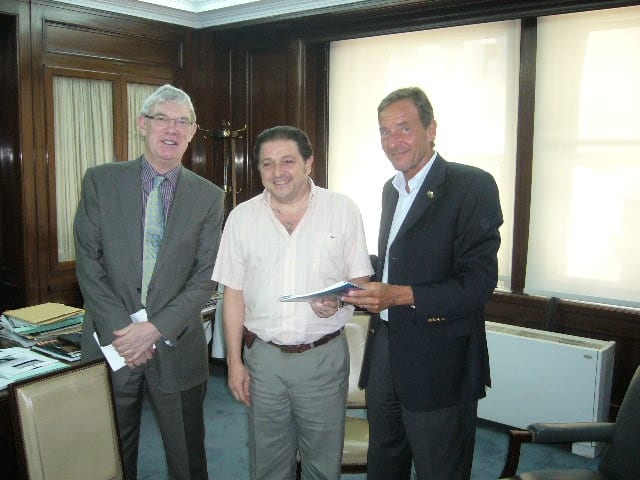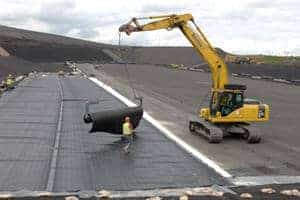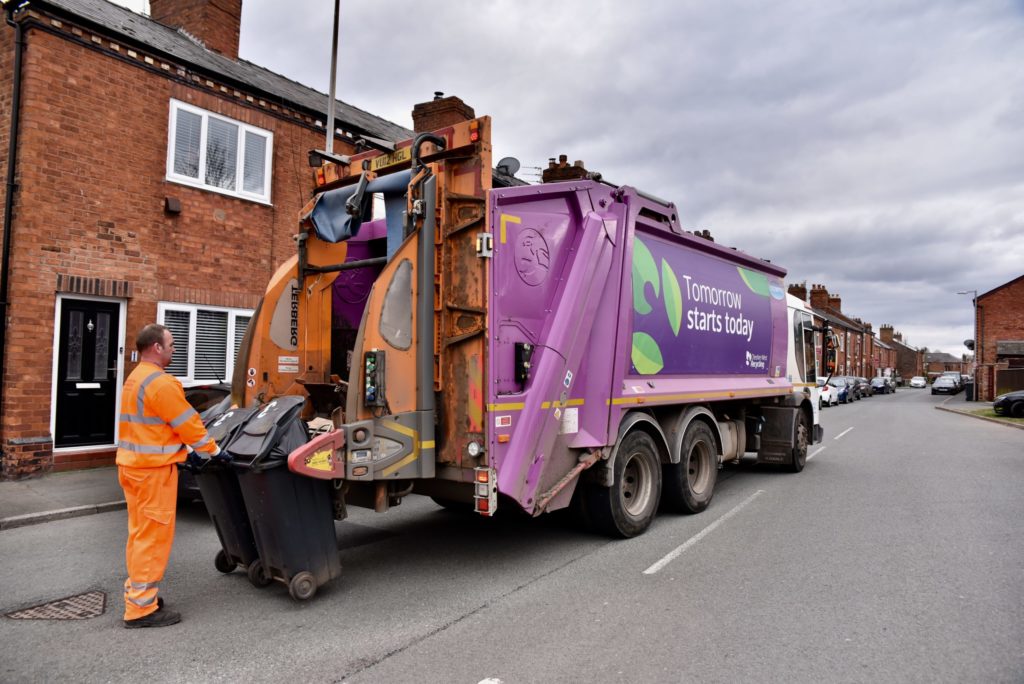ISWA met with Pablo Mesa, the chief civil servant responsible for the National Strategy for Integrated Solid Waste Management (ENGIRSU) in the Secretariat for Environment and Sustainable Development in the Argentine Ministry for Health and the Environment. A draft strategy was launched at the end of 2003 and was subject to a year of extensive consultation, including: provinces, municipalities, NGOs and the academic community. It was approved by the government and started operating at the beginning of 2005.
Argentina has a population of about 40 million people, although the estimate may be wildly out as there has not been a census in the country since the 1980s. There are about 2,000 municipalities within 24 Provinces. One third of the population live in the Greater Buenos Aires area.
The ENGIRSU has an overall objective the development of an integrated waste management system but given the lack of even rudimentary waste services in most places the initial short-term main aim of the strategy was to divert as much residual waste as possible into sanitary landfills. Open dumps are the most common means of dealing with residual waste throughout Argentina.
As with many other countries the municipalities complain that they do not have the resources to establish sanitary landfills. While the finance to establish proper landfill operations is certainly an issue Mr Mesa and Dr Savino thought that there was an issue regarding the willingness of municipalities to address the problem. It was often easier to, for example, improve the pavements rather than tackle a more pressing health and environment issue.
One major difficulty was that almost as soon as the strategy was launched there was a change of national government in Argentina and the strategy was abandoned for more than two years with no funding being provided for the improvement of waste management. In January 2009, however, with a further change in government the Ssrategy was re-launched with Mr Mesa acting as the national co-ordinator with a small team of 20 people based in the Environment Ministry.
The strategy therefore tries to ensure that there is access for all municipalities to training, education and the results of government-sponsored projects that act as exemplar case studies. There are other ways of capacity building and the Ministry also posts prices being paid for the most common recyclable materials that can be reclaimed from MSW, similar to the service that WRAP provides for Defra.
There are a number of example case studies being funded by a variety of sources and these are arranged as a number of programmes. The World Bank has provided loans to the Argentine government for the development of integrated waste management systems.
The Inter-American Development Bank (IDB) has provided funds to improve waste management of municipalities heavily dependent on tourism. There is a third programme provided with funding from the Argentine government, including finance from other ministries.
The number of projects that can be sponsored is small in comparison to the need, 30 projects from the World Bank and IDB combined and 50 from the Argentine government and municipalities own sources. Establishing what is needed is also a difficult problem because there are few reliable statistics about waste generation, treatment or disposal.
If it is not on the municipality's agenda there is no need to have information. Therefore the Ministry which acts a central source for information and waste statistics is forced to make a large number of assumptions regarding generation, treatment and disposal of MSW.
For some municipalities there is sometimes a misperception about the waste they have access to and the ways which that waste can be treated. Some think that their waste has such high value that they should be making money from it, not tackling the basic health and environment protection issues.
One municipality of 20,000 in Córdoba Province applied to the Ministry for funding for a plasma arc treatment plant. There are other examples of municipalities thinking that there is a single magic bullet to solve their waste problems and simply having a zero waste policy will make the waste disappear.
Waste workshop
The importance of proper preparation and planning for new waste management facilities was reinforced and exemplified by Antonis Mavropoulos, the chair of the ISWA Scientific and Technical Committee. He provided a half-day workshop for CEAMSE, the waste management company that provides waste transfer and disposal services for the City of Buenos Aires.
The company is currently operating a huge landfill site, Norte III plus two others, which take in 15,000 tonnes per day of residual waste. There is a planned Norte IV designed to take over when the Norte III facility is full in 2 years' time but now there is increasing opposition from local residents and nimbyism over landfill is rife. Mr Mavropoulos was requested by the management of CEAMSE to run a workshop for a range of key staff in order to focus on what is needed to resolve the problem.
There is increasing opposition from local residents and nimbyism over landfill is rife
Jeff Cooper
He stressed that waste is often looked at by professional waste managers as a technical problem to be solved within the constraints of legislative provision and finance. In reality it is a social problem. There needs to be a common view of the issue through everyone, including the public and politicians, improving their appreciation of the waste management problem and potential solutions.
There is a need for everyone to appreciate that good solid waste management is like good health and Mr Mavropoulos cited the fact that the last epidemic of the plague, near Mumbai in 1992 affected 3,000 people and was spread through the sorting of waste at open dumps. Waste is a part of cultural behaviour and waste reflects societal values as a whole.
Politically waste management an issue best avoided because it handled wrongly it can be a vote loser but rarely are votes to be gained from tackling waste.
Tackling waste is overwhelmingly dependent on the amount of GDP per capita and thus runs from no collections at the one extreme through to sophisticated separation, treatment and utilisation of residues at the other. He also noted that waste management systems are not necessarily transferable from one country to another.
To exemplify the difficulty of transferring waste solutions he cited the development of an Italian designed MBT plant built on the outskirts of Athens. Planning started in 1992 when the daily residual waste generated in the capital city was 1,000 tonnes per day (tpd). Construction started in 1999 and finished in 2003 at a capacity of 1,200 tpd is the biggest in Europe with the EU funding the €80m cost.
The MBT plant was designed to produce two main products: a compost-like output (CLO) and refuse-derived fuel (RDF) plus sorting out any recyclable wastes. However, by the time the plant opened in 2003 Athens daily waste generation had reached 6,000 tpd. In addition, the CLO could not be used as a compost and the cement kilns expected to burn the RDF demanded a €35 a tonne fee, transport to the kilns and money for new emission filter systems. Now both output streams go to landfill. Of course Italy has the problem of 7 million tonnes of RDF/SRF “stored” throughout the country.
Environment
The Secretary of Environment and Sustainable Development of Argentina, Dr Homero Máximo Bibiloni in the Secretariat for Environment and Sustainable Development in the Argentine Ministry for Health and the Environment discussed waste and climate change.
Dr Bibiloni was presented with copies of the ISWA White Paper Waste and Climate Change. Dr Savino announced that it has already been translated into Spanish and was ready for publication. Dr Bibiloni acknowledged that there was a need for integrated waste management in all countries to reduce emissions of greenhouse gases.
He stated that when the Copenhagen Accord is ratified there would be considerable funding from the Annex I countries to allow Argentina more easily to access the CDM (clean development mechanism) to improve the disposal of waste by utilising the landfill gas. One barrier to greater utilisation of gas is the low price of energy in Argentina, which has huge reserves of natural gas and also uses low cost liquefied petroleum gas extensively in cars and buses. Dr Bibiloni was encouraging other ministries to support his environmental objectives therefore by, for example, encouraging the agricultural ministry to look at ways of reducing methane and ensuring greater carbon storage. Some initiatives have already started with, for instance, the residues from lemons of which Argentina is a leading grower being used for an energy source and Coca Cola takes a high proportion of the output. The Energy Ministry was now calling for renewable energy projects for which some subsidy would be provided.
Dr Bibiloni was looking at ways in which the smaller municipalities could join together to provide waste services in common, especially the development of regional landfill sites. The existing World Bank and IDB funding encourage such joint initiatives and he was hopeful of accessing further funding from these sources after May 2010.
One of the most pressing issues he was having to tackle was the issue of pollution in the Cuenca Matanza Riachuelo Basin which is the waterway next to the main tourist site at La Boca. Although the pollution was not solely the responsibility of waste generators and disposal companies it was part of the problem and the Supreme Court of Justice was requiring the Ministry to resolve the problem.
Climate
Dr Hernan Carlino, Co-ordinator for the Climate Change Unit in the Secretariat for Environment and Sustainable Development in the Argentine Ministry for Health and the Environment stressed the impact which climate change was already having and its potential future significance. He noted that each of the reports prepared by the IPCC (Inter-governmental Panel on Climate Change) was more definite about the existing impacts and the future risks of climate change. Regionally the impact could be seen from the fact that of the 50 glaciers in South America 48 were receding.
Dr Carlino noted that while international regulation was important and market instruments would be significant in producing a response based on the precautionary principle, different solutions were required for different gases and new technologies had to be adopted to ensure an appropriate response in a market based economy. However, having attended the recent COP15 meeting in Denmark and all the COP meetings and preparatory meetings over the past decade Dr Carlino was not happy with the outcome from Copenhagen.
Dr Carlino noted that there were still countries that had not yet joined the Copenhagen Accord agreed on 18 December, although a deadline of 31 January had been set. It appeared that it would take a considerable time to put into effect the political agreements reached at Copenhagen with the funding not coming on stream for several years.
On the street
There are between 5-9,000 cartoneros working the streets of Buenos Aires, usually in small groups, often with a suitably weight challenged person used as a human compactor. But how effective are they in recycling Buenos Aires waste? While official statistics are absent, estimates place the amount at about 36,000 tonnes a year, equivalent to just two and a half days of residual waste going to landfill.
In an integrated waste management system recycling has the greatest potential to reduce potential environmental impacts by returning waste to the production cycle. Certainly in Buenos Aires the cartoneros ensure that all the potentially recoverable paper, cardboard, hard plastics and metals are extracted from the mixed waste bags, skips and other containers before the normal waste collection crews can put the waste into their vehicles for disposal to landfill. However, after they had done their sorting the surrounding pavements and streets are heavily littered with residual waste.
The City administration has made some efforts in the past to develop source separation facilities for recyclable wastes but these have only ever been pursued on a pilot basis. Generally, after a while for either cost reasons or because the cartoneros regarded them as an easy source of supply, the trials have been abandoned.













Subscribe for free